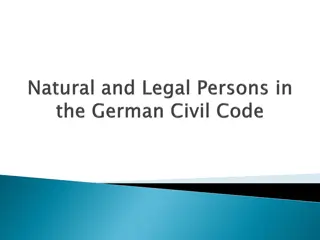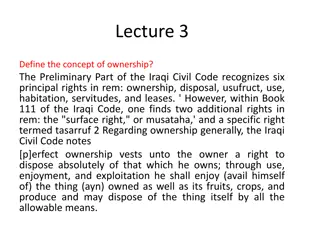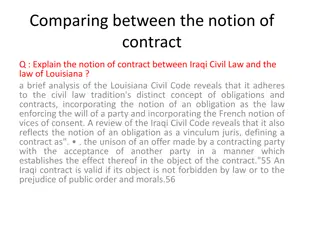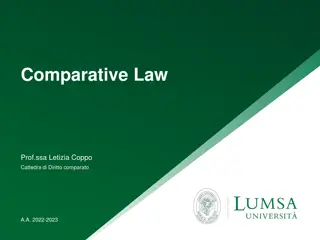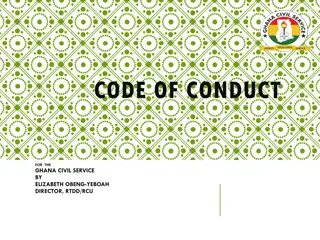The Making of the Code Civil (1804) and the BGB (1900)
This lecture provides a historical overview of the development of two significant civil codes - the French Code Civil of 1804 and the German BGB of 1900. It explores the political events in France and Europe from 1750 to 1815, leading up to the creation of these codes amidst revolutionary movements and societal challenges.
Download Presentation

Please find below an Image/Link to download the presentation.
The content on the website is provided AS IS for your information and personal use only. It may not be sold, licensed, or shared on other websites without obtaining consent from the author. Download presentation by click this link. If you encounter any issues during the download, it is possible that the publisher has removed the file from their server.
E N D
Presentation Transcript
Continental European Constitutional and Legal History: The Making of the Code Civil (1804) and of the BGB (1900) Lecture 23 Click here for a printed outline.
Sketch of events (17501815) In this lecture I want to sketch out, and I emphasize sketch , the story of two civil codes, that of France of 1804 and that of Germany in 1900. For the undergraduates this is not something for which we hold you responsible on the exam, but we really should say something about the ending point of our story, if only because the ending point is still with us to this day. Both stories are complicated but they make no sense unless they are put in some kind of context. So let me begin with some political events that form an important part of the context for the French Civil Code of 1804, the Code Napol on, the Code Civil.
Sketch of events (17501815) (contd) Louis XV was not the man that his great-grandfather had been. The French nobility once more came to the fore, and the parlement of Paris renewed its role as a check on the monarchy. The middle years of the 18th century were a period of wars, largely the result of Frederick II of Prussia s seizure of Silesia when he thought he could take advantage of the weakness of Maria Theresa of Austria. Shifting alliances ended with Frederick opposed to France, Austria, and Russia, but with the help of English money he survived and retained Silesia, though his power was checked. The end of the Seven Years War left France no stronger than before, perhaps weaker, and faced with the beginnings of a crisis at home caused by growing population, a rigid class structure, great disparities of wealth, and an antiquated governmental structure. That crisis was to end in a revolution.
Sketch of events (17501815) (contd) There are those who see the French Revolution as part of a much wider movement in the western world. It has even been called the age of democratic revolution (R.R. Palmer). In favor of this interpretation is the fact that there were revolutionary movements in Geneva in the 1760s (and again in the 1790s), in America in 1770s, and in Ireland, Poland, the Northern Netherlands and the Austrian Netherlands in the 1780s, and in Hungary in 1790. It s probably a good thing to point this out, just like it s a good thing to point out that the French Revolution was not the necessary product of the Enlightenment. Indeed, many Enlightenment thinkers were appalled by it. At the same time, I think we may have gone too far in the other direction. The events in Ireland, Poland and the Austrian Netherlands in the 1780s have much to do with struggles of people of a given ethnic group against foreign rulers. The same can probably be said of Hungary in 1790, although there it was also a reaction to the emperor Joseph II. The foreign element is totally lacking in the French Revolution.
Sketch of events (17501815) (contd) The revolt in the Northern Netherlands in the 1780s does have some democratic elements, but the Northern Netherlands were already a republic, and the revolution can also be seen as a continuation of the struggles that had been going on for more than a century between the center and the units that made up the country. The American Revolution, as we all know, was largely the product of a change in colonial policy that brought the colonies in opposition to the mother country. That leaves Geneva, which does have some similarity to France, a movement against a ruling oligarchy, but Geneva was a small republic dominated by religion, not the largest and potentially the most powerful country on the Continent. It is only in the French Revolution that one gets the sense that absolutely everything is up for grabs. .
Sketch of events (17501815) (contd) There are also those who see the French Revolution as triggered by economic causes, and again, there is something to this. The peace that followed the Treaty of Utrecht in 1714 and which was only interrupted by the wars in the mid-18th century brought unprecedented prosperity to France and also an unprecedented rise in population. The wars of mid- century broke the economic expansion without reducing the population. Many people in France in the 1770s and 1780s could remember when they had been better off. A series of bad harvests did nothing to alleviate the problem, though we may doubt whether the famine was anything like as prevalent or as serious as it had been in 1709 1710. The chaotic state of government finances suggested for many people an explanation for why the economy was in such bad shape. The 18th century was a time in which many men believed that they could control their destiny. The refusal of the government to make what seemed to many to be obvious reforms ignited a powder keg. .
Sketch of events (17501815) (contd) So much for the origins of the Revolution, let s look at the Revolution itself in institutional history. For it is in the institutional history that we find the makings of the Napoleonic Code, and also the seeds of what is to be the range of possible choices in public law that have dominated the two succeeding centuries. Legally, the French Revolution represents the triumph of positive public law. The way had been paved, to a certain extent, by the American Revolution, but when the French Revolution began the French did not know about the American constitution, and American constitutionalism did not prove particularly influential in the numerous constitutions that France adopted over the twenty year period. I am not going to go through them all. I d like to make a couple of general points:
Sketch of events (17501815) (contd) May 1789 Sep .1791. The Estates General and Constituent Assembly. The first stage of the Revolution produced much that lasted. The Declaration of the Rights of Man takes its place along with the Declaration of Independence and the English Bill of Rights as among the most significant documents of practical constitutionalism. The abolition of the traditional local jurisdictions and the permanent vacation decreed for the parlements signaled a radical change in local government and a complete restructuring of the legal profession. The civil organization of the clergy, on the other hand, was but a step on the way to the ensuing radical secularization of the state. The notion of a monarchy subject to a written constitution was new. The abolition of traditional privileges of the nobility and the clergy began the characteristic of all modern liberal states that economic classes have no legal privileges. The creation, however, of a limited franchise was to prove to be one of the most divisive issues of the 19th century: How to ensure the government of what they called the best men and not of the mob? Although the king is now gone and limited franchise is a thing of the past, many of the fundamental characteristics of the public law of modern France, and, I might say, of modern Europe, were created in a period of less than 18 months. Among them was the use of criminal juries, not an institution that lasted in France, but the influence from England at this point was strong. I now skip over eight chaotic years and move to the:
Sketch of events (17501815) (contd) Dec. 1799 May 1804. Consulate. Napoleon s constitutions are normally regarded as shams. Certainly their use of terms from the Roman Republic, consul, senate, tribunate, do not reflect either the contemporary reality or the Roman one, any more than does our Senate which gives advice and consent like the Roman body of the same name. This period was fascinated with classical antiquity. Those of you who are familiar with the art of the period know that it was an era of neo-Classicism in more than government. In the area of government, it would seem that one of the things that makes the Roman model attractive is its very secularization. That in turn makes even more bizarre the Concordat with the papacy in 1801, a continuing effect of which is that one of the most radically secular governments in Western Europe still approves episcopal appointments in France. Perhaps a more important institutional feature of this period was the revival of a Council of State, which had some of the features of modern cabinet government. Even more important was Napoleon s reorganization of his German dependencies. By and large this reorganization survived, making the ultimate unification of Germany in the 19th century easier. The civil code was written and promulgated in this period, though it came into effect in the first empire. The Council of State played a significant role and the tribunate played some role.
Sketch of events (17501815) (contd) May 1804 June 1815. First Empire. The creation of Napoleon as emperor has been likened to a modern dictatorship. I am not entirely sure that the analogy is completely apt. Much depends on the extent to which the notion of the rule of law was lost in this period. Certainly the main events of this period showed that even a Napoleon and even with a draft, which enabled him to raise huge armies in comparison with those of the 18th century, was not able to dominate Europe when he failed to take diplomatic advantage. Large as France was, it was not as large as England, Germany, Austria, and Russia combined, particularly when France lost control of the sea and began to lose parts of her empire. Whether Napoleon s ultimate failure is one of personality or of class (no one with origins as humble as Napoleon s could be a ruler for long in early 19th c. Europe) is much harder to figure out. He was defeated, however, by outside forces, not from within. And much that he achieved or that was carried on from the Revolution lasted, including, most notably, his Code.
Why was there a codification in France in 1804? A list of 18th-century codifications can be found on the outline. Why was there codification in France in 1804? Let me give you three answers that are still respectable in the literature: For the first answer I turn to a French civil lawyer named Jean Maillet. He represents what may be called the traditional answer. He divides the reasons into two groups: (1) technical preconditions and (2) societal driving forces. Two of Maillet s technical preconditions we have already talked about: (a) Roman law and (b) rationalization, the desire to systematize. The third one is an institutional French reason: the role of judges and the parlements. We have already noted that French judges operated on a local level. They were regarded simply as delegates of the sovereign and the notion always was that they ought mechanically to apply the sovereign s will. The parlements, on the other hand, had considerably more power. But they were faced with a largely appellate business from a very diverse group of customs. It was natural for them to get involved in law reform as a legislative rather than a judicial matter.
Why was there a codification in France in 1804? (contd) When the parlements were sent on their permanent vacation it was only natural that legislative bodies should take over and that their focus should be on legislation. Of societal driving forces Maillet lists three: (a) move to modernity, (b) equality, (c) unification of the country and a desire to eliminate foreign influences. The first may be associated with the Enlightenment, the second with the rhetoric if not the reality of the Revolution, the third with the Revolution so far as unification is concerned and with Napoleon so far as the elimination of foreign influences is concerned. Maillet s bottom line is that the technical factors were there in Colbert s time (an argument which rather undercuts his notion that the vacation of the parlements was important) but it took the revolution to produce the social factors. The analysis has obvious problems. Bavaria, Prussia and Austria all had codifications that antedate the French, and none of these places had a revolution until 1848. Further, the drive to eliminate foreign influences sits curiously on a codification that owes so much to Roman law. That drive, however, may have more to do with appearances than realities.
Why was there a codification in France in 1804? (contd) There is something to Maillet s argument, but we must test his thesis by looking Europe-wide. By and large it is the French codification that was influential, not least because Napoleon spread it all over his empire. But most of the Codes adopted in the 19th century, in fact, were adopted in areas where Napoleon never set foot or where his influence was weak, notably Spain and a large portion of Latin America. One count suggests that it was adopted in 35 countries and strongly influenced the code of 35 others. Now I would suggest that there are two phenomena to explain: why codification and why this particular code?
Why was there a codification in France in 1804? (contd) Alan Watson offers a strong counter-argument to Maillet. He starts off with two basic arguments: (1) He concedes that there must, of course, be a political base for codification, but he argues that this base must be very common because the phenomenon of codification is common. (2) Codifications rarely exist in common-law countries. That leads him to suggest four arguments: (a) A desire to systematize and reduce the multiplicity of sources of law is a necessary but not a sufficient condition to produce codification. (b) Revolution is not necessary; Bavaria, Austria, and Prussia all codified without revolution. (c) Napoleon could force it through in France, but Bentham and Field could not in England and the United States. Savigny in Germany, about whom we ll talk in a moment, could stop it only for a generation. (d) In all the places in which codes were adopted, codification came after the institutes of national law, after a period in which natural law had been extensively explored, and after generations of the teaching of the Digest. It is for this reason that Watson points to Roman law as the single most important factor in codification.
Why was there a codification in France in 1804? (contd) I too believe that Roman law was important, but I am inclined to think that Watson underemphasizes the importance of the Napoleonic Code. Neither the Prussian Code nor the Austrian Code had much influence, and the Prussian Code is a really quite different product. The Bavarian Code was really a compilation rather than a Code. If we seek to explain why the Continental countries codified and by and large the Anglo-American did not, the strength of the Roman law tradition with all that that entails may help. If, however, we seek to explain why the Continental countries codified in the way that they did, then the French example must come to the fore. I am also not entirely sure that Revolution cannot go a long to explaining why the Napoleonic codification proved so popular. Many of the 70 countries that adopted Napoleonic codifications in the 19th century were in Latin America, and in every one of those countries adoption of the Code was a symbol of their breaking off from their Spanish or Portuguese colonial ancestry.
Why was there a codification in France in 1804? (contd) Carl Friedrich, the great Harvard historian of political thought of the last generation, sees the Napoleonic Code as a typical Enlightenment product. The French, he notes, were heavily influenced by Rousseau, particularly Rousseau in his more communitarian aspects. The French, as he sees it, saw law as constitutive of their political community. Does this help? Well, it may not help to explain the fact of codification, but it may help to explain this particular codification. Although the Napoleonic Code became the Bible of the individualist liberals (who in 19th century Europe were much more like today s Republicans than they were like what we call liberal), but in the Napoleonic Code itself the communitarian element is strong, particularly in the case of the family.
Why was there a codification in France in 1804? (contd) Obviously, however, if we get down to this level, then we must ask about who was involved. Napoleon was important, and we know that Napoleon was influenced by Rousseau particularly the Rousseau of the Contrat Social rather than Rousseau in his more Romantic and individualistic aspects. But there was also a drafting commission of four. All of them were quite old. Fran ois Tronchet, 1726 1806, from Paris, the defender of Louis XVI in the National Convention, former president of the Parlement of Paris. F lix Bigot de Pr amenu, 1747 1825, born at Rennes in Brittany, and former member of the Breton parlement and advocate in the parlement of Paris. These represented the pays de droit coutumier. From the pays de droit crit were Jacques, marquis de Maleville (1741 1824) and Jean Portalis, 1746 1807. Of these probably the most important was Portalis, who drafted the general sections and an introduction. Another figure of great importance was Jean- Jacques de Cambac r s, 1753 1824, who was the second consul and ultimately archchancellor of the Empire. He prepared two drafts of a code for the National Convention that were used as the basis of the final draft that was adopted. He also organized the drafting of the other Napoleonic Codes. He, too, was from the pays de droit crit. That the code that ultimately emerged has been estimated to derive 2/3 from Roman law and only 1/3 from French customary law may not totally be result the legal origins of Maleville, Portalis, and Cambac r s, but it certainly has something to do with it.
Outline of the Napoleonic Code The Napoleonic Code is divided into three books: bk. 1. Of Persons. (This is where the marriage sections are found.) bk. 2. Of Property. bk. 3. Of the different modes of acquiring property. (This is where the wild animal section is found.) After the introduction to bk. 3 come: 1. Succession. 2. Donation. 3. Contracts in general. 4. Engagements formed without a contract (quasi- contract and delict). 5. Of the contract of marriage (marital property). 6 13. [Different kinds of contracts: sale, hire, partnership, loans, deposit, insurance, agency] 14 18. Security. 19. Ejectment. 20. Prescription. (The section on witnesses is in a separate Code of Civil Procedure.)
Outline of the Napoleonic Code (contd) The structure of the Code shows obvious influences of Justinian s Institutes, as had the institutional treatises that preceded it. The substantive contents of the Code, however, are a mixture of Roman law and French custom. If you have been following what we have been saying about the way the blend of the two was happening in the ancien r gime, it will not surprise you to learn that the law of obligations in the Code, an area in which customary law was notably deficient, is largely governed by Roman substantive principles, whereas the law of marital property and succession, where the customary law was very rich, is largely governed by customary principles. Where the Revolution played a role was in the area of property other than the law of marital property and succession. Here the customary law was all mixed up with material that the codifiers regarded as feudal. They bagged it all to substitute a body of principle that certainly has Roman overtones, though we may doubt how Roman it really was. The Revolution also played a role in the substantive provisions about marriage. These are largely canonic, but they have been radically secularized.
Outline of the Napoleonic Code (contd) The provisions are logical in order and characterized by great simplicity. Here too the Revolution and Enlightenment thought plays a role. Sweeping aside ancient complexities in the light of common-sense goals is very much an Enlightenment idea; creating a Code that everyone can read and seems not to need professionally trained lawyers and judges to interpret it is very much a Revolutionary idea. One of the rallying cries of the Revolution was the elimination of the gouvernment des juges, the government of judges, and the government of judges remains to this day the Frenchman s idea of hell. But there is an irony here. The very simplicity of the Code means, necessarily, that there is considerable room for interpretation. The lawyer might not be totally taken out of the picture. Portalis knew that, but he thought that the judge and the jurist could be tamed.
The so-called exegetical school and the Napoleonic Code Whatever there was about this document it convinced some not stupid people that it was possible to interpret it within its four corners. The school of jurists that followed, the so-called exegetical school , seemed to have believed that it was doing just that. In our world where we believe that everything is ambiguous, we wonder how anyone could be fooled, but fooled they were, or perhaps it is we who are fooled. Perhaps we should adopt the post-modern notion of the interpretive community and suggest that it is found in the focus of the exegetical school on the abstraction of the legislator, whose mind they must discern..
The exegetical school and the Napoleonic Code (contd) It is not until we get the first generation of lawyers who were brought up entirely on the Code that we get the true development of the exegetical school. Alexandre Duranton (d. 1866), professor at Paris, published a commentary on the code in 21 vols. Raymond Troplong (d. 1869), magistrate and president of the cour de cassation, published a commentary in 27 vols. Charles Demolombe (d. 1888) reached 31 vols. in his commentary. The leading theoretical light of the school, however, was not a Frenchman but a Belgian, Fran ois Laurent (d. 1887), a professor at Ghent, at this time a French-speaking university. His thought may be characterized as follows: (1) He was a liberal and violently anti-clerical. (2) He fulminated against the tyranny of the judges, whom he accused of not paying proper deference to the code. (3) He believed that law was a rational science, deductive, but not deductive from principles of natural law or principles to be found in the nature of legal concepts themselves, but principles to be found in the code. (4) The task of scholarship, he said, was not to reform the statute but to explain it. Statute, he said, even if it were a thousand times absurd, would still have to be followed to the letter, because the text is clear and formal. And the code, because it is so well-drafted, covers all, or virtually all, situations. The unprovided-for case is simply an uninteresting proposition.
The exegetical school and the Napoleonic Code (contd) Laurent was extreme. Perhaps more typical were Charles Aubry and Charles Rau, professors at the university of Strasbourg, who began by translating a German commentary on the code, but eventually ended up with one of the most popular commentaries on the code (only 8 volumes), still being published today. Very little attention was paid to case law, although there was some, particularly as the judges hesitantly began to develop the concept of delict. But it was the professors whose approval led the judges, not the other way around. As the 19th century wore on, Roman law was cited less and less. The origins of the provisions of the code were forgotten and professors came more and more to cite one another, and the judges cited the professors.
Sketch of events, 18151914 Let s say more about the Continental codification movement in the nineteenth century, and particularly Germany. I must assume that you are at least vaguely familiar with the political and institutional events of the 19th century that are listed on the outline. Let me begin by reminding you of the key events. The Industrial Revolution is usually treated in history books as a phenomenon of the late 18th century. Indeed, many of the important inventions that gave rise to the Industrial Revolution were made in the 18th century and some industrialization may be seen in England at the end of the century. The modern tendency, however, is to emphasize how much it is socially a 19th century phenomenon. England industrializes first at the beginning of the century, and it is probably for that reason that political reforms, particularly those associated with reform of the electoral system and widening of the franchise, come fairly early in the century. In France and Germany the phenomenon is more a product of mid-century, though it had advanced far enough by 1848 that the treatment of industrial workers, the urban proletariat, could be a major issue in the revolutions of 1848. If this analysis is correct, then the revolutions of 1830 can be seen more as a continuation of the consequences of the French revolution and the Napoleonic period.
Sketch of events, 18151914 (contd) In our fascination with the Industrial Revolution we should not forget that a large proportion of the population of Europe was still engaged in agriculture. That remains the case even to this day, as can be seen from the fact that agricultural policy is still a major sticking point in trade negotiations. In France the agricultural workers, the peasants, who had as a result of the Revolution become small proprietors remained a quite conservative force, uninterested either in the more radical ideas of the bourgeois liberals, particularly in their anti-clericalism, and certainly uninterested in the ideas of the socialists and communists who emerged in the revolution of 1848 as a new and potentially radically disruptive force.
Sketch of events, 18151914 (contd) In Germany, however, where vestiges of what was still called feudalism remained in some of the principalities, the problem of liberal reform was closely connected with the problem of agrarian reform, the so-called Agrarfrage that dominated as a practical issue in legal thought in the first half of the century. In Italy, a largely unreformed agricultural system was coupled with the problem of foreign rule. (Austria had acquired substantial territory in northern Italy as a result of the Congress of Vienna in 1815.) The radical Garibaldi was able to unite peasants and the urban proletariat in his campaigns that sought at once to upset the old order and to unify the country. Russia and Austria remained autocracies where the old nobility still had a large measure of power. Industrialization was not a substantial issue in these countries, and reform came about largely by granting occasional concessions to the peasants and to subject peoples, for Eastern Europe was then as it is now an area of great ethnic diversity.
Sketch of events, 18151914 (contd) In Germany the Revolution of 1848 did not succeed perhaps because of the inability of the bourgeois and the workers, both agricultural and industrial, to unite around a new form of government. Prussia was badly shaken by the Revolution and Austria took advantage of it to halt Prussia s steady rise to dominance in the German confederation. A customs union (Zollverein) had existed since 1819. France emerged more powerful under Napoleon III. In Italy, however, the forces unleashed by the revolution led ultimately to the unification of the country under Victor Emmanuel of the house of Savoy and his liberal minister Carvour. By 1867, the last of the independent states in the peninsula, the papal states, were brought under the control of the new king. The pope was paid an indemnity and became, as the phrase went, the prisoner of the Vatican.
Sketch of events, 18151914 (contd) Twenty-two years after the Revolutions of 1848, the balance of power that had emerged from them was reversed. Prussia defeated France in the Franco-Prussian war; Napoleon III was out of power; France was now a Republic, considerably weaker than before; Prussia, on the other hand, finally succeeded in unifying Germany under her king, who became Kaiser Wilhelm I, and his extraordinary chief minister, Bismarck.
Sketch of events, 18151914 (contd) The one event on the outline so far that doesn t seem to fit is the Crimean War and the Peace of Paris of 1856 that ended it. Obviously, what is going on around the Black Sea and in the Balkans has very little to do with the great political and social events that were dominating Europe. The war, however, is there as a reminder that diplomacy and war in the 19th century, as in our own, was frequently intimately connected with changes in power relations in areas far from the heart of Europe. I probably do not need to remind you that it was events in the Balkans that triggered the Great War of 1914 1918.
Sketch of events, 18151914 (contd) It is one thing to say that Prussia under Bismarck was able to unify Germany; it is quite another thing to say that the unification would stick. Although the Germans, except for the eastern fringe, spoke a common language, and shared a common culture, they had not been united politically since the Middle Ages, and the medieval unity, such as it was, was quite different from the unity of a modern nation-state. The religious differences that had separated the German principalities since the Reformation remained, and to this might be added a third religion, liberalism, which in its opposition to organized religion took on many of the characteristics of a religion.
Sketch of events, 18151914 (contd) Laid over these religious differences were political differences, the conservatives, liberals, center and radicals all had parties , though the parties were not as developed as they were in, say, England. While the conservatives and the center tended to be clustered among believers, there was no unity among believers because the Catholic center party and the conservative Lutherans did not get along. The liberals and the radicals tended to be anti-religious, but they hardly agreed on any other issue. Bismarck is certainly not one of the most attractive figures in history, but his achievement for all of that was quite remarkable. A conservative from a staunchly Lutheran area, he was able to forge a powerful state out of extraordinarily disparate elements. He also had the sense, as his successors did not, to keep the lid on German expansionist tendencies.
Sketch of events, 18151914 (contd) One of the areas that illustrates quite well both the difficulty and the techniques of forging a state out of Germany is one of our continual topics, marriage. Both Lutherans and Catholics tended to favor not only religious marriage but also the jurisdiction of the church over questions of marriage. A pluralist approach might have allowed each side to choose its own forms of marriage and its own jurisdiction. There were at least hints of that in the Austrian Code of 1811, and suggestions of that solution may be found even in the Spanish Civil Code of 1889. But the Napoleonic Code had taught that marriage was a matter for the state, a constitutive element in the unity that makes up the state. The liberals argued for a single required state marriage ceremony like that of the Napoleonic Code. The ensuing debate produced some of the first modern historical scholarship on the development of the forms of marriage in Germanic and canon law. The conservative Lutherans staunchly held to the religious model, but also, true their tradition, that the religious form of marriage must be enforced by the state. The Catholics, however, were divided. A number of prominent German Catholics had rejected the proclamation of papal infallibility at the First Vatican Council in 1870, becoming instead a type of schismatic called Old Catholics.
Sketch of events, 18151914 (contd) Eventually the Catholic center party only weakly resisted the liberals proposals for civil marriage, and Bismarck abandoned his conservative Lutheran colleagues. Obligatory civil marriage was adopted in 1875. The debate about marriage must be placed in the wider context of what is known as the Cultural Battle (Kulturkampf) about religion. If liberals and Lutherans could agree, they had the power to suppress Catholicism in Germany at the expense of unity. Considerable efforts in this direction were made. The Jesuits were expelled; religious orders were suppressed. The papacy, obviously, resisted; so did most German Catholics. Again, Bismarck compromised. Negotiations with the papacy took place. While no concordat was signed in Bismarck s time, Bismarck s need for support from the Catholic party for his tariff law of 1879 led to gradual amelioration of anti-Catholic legislation.
Sketch of events, 18151914 (contd) During Bismarck s period industrialization of Germany proceeded rapidly. She became one of the world s great industrial powers. Obviously, this enhanced the political power of the liberals who were largely associated with the entrepreneurs that made this possible, and put into opposition both the peasants and the industrial workers. Bismarck was no liberal. He was a conservative of the old style. His introduction of a social security system into Germany, the first in the modern world, may be seen as an effort to prevent industrial workers from revolting or from getting too much political power, but it nonetheless represents an achievement that would have far- reaching implications.
Sketch of events, 18151914 (contd) One of the projects that Bismarck began, though it was not completed until after his fall from power occasioned by his move against the socialists was the codification of German Civil Law. As you can see from the outline, commercial law was codified in Germany even before there was complete official unity. Civil procedure was codified during Bismarck s time. Obviously, political unification and codification go hand in hand. Nonetheless, if we look at the substance of these codes, there is much in them that is hard to explain in terms of the great issues of the day. Efforts have been made to describe the German Civil Code as either liberal or conservative, as either religious or anti-religious, but the great political issues of the day are only dimly reflected in it. The Civil Code did carry forward the legislation of 1875 on civil marriage, and in that respect we can see one of the great issues of the day reflected in it, but compared to, let us say, the Social Security law, there is little in the code that seems directly relevant. Now my argument is going to be that the German Civil Code of 1900 is very much a product of its time, indeed very much a product of the politics of its time, but the political connections are more subtle than what most people have been looking for. In order to make this point, I want to look first at the European codification movement generally and then at the intellectual background for the German Civil Code.
A century of codification (contd) The outline shows, if nothing else, that a simple view that states that the French codified in 1804 and the Germans in 1900 considerably overstates the gap between the two codifications. We have already seen that Napoleon brought his codes with him. The Rhineland, for example, adopted the Napoleonic code and kept it throughout the 19th century. The Low Countries, too, accepted the codification and after the defeat of Napoleon turned to their own codes that were largely based on the French model. The date for the Austrian code would also suggest Napoleonic influence, and indeed, there was some there, but the Austrian story, as we have seen, is much more complicated. There was a move to codification begun under Maria Theresa, and the Napoleonic code seems to have provided more of an impetus for an already ongoing effort than for a totally new departure.
A century of codification (contd) The dates also suggest, and this is correct, that after the defeat of Napoleon there was something of a hiatus in codification efforts at the national level. The movement begins again after the revolutions of 1848, remarkably enough with the Spanish Code of Civil Procedure, a phenomenon that I do not believe has been adequately studied. It seems to be connected with the revolution of General O Donnell in 1854. It is followed by the Commercial Code in Germany of 1861, the Italian Civil Code of 1865, and so on. Each of these moments are related to the politics of the country in which they occurred. The Italian Civil Code of 1865 is, of course, a product of the unification of the country under Garibaldi and Cavour, but to focus on it is to forget the fact that many of the areas that were unified already had their own codes. The Spanish Civil Code can be connected with the reforms under the regency of Maria Cristina, widow of Alfonso XII and mother of Alfonso XIII. Similarly, what was going on Germany, the Commercial Code of 1861, the Civil Procedure Code of 1877, ultimately the Civil Code of 1900, is intimately connected with the unification of the country under Prussia. It is also, however, connected with an intellectual movement or series of movements to which we now must turn:
German Juristic Science in the 19th Century What follows is based on a remarkable book by James Q. Whitman, called The Legacy of Roman Law in Romantic Germany. After the defeat of Napoleon, as we mentioned above, a number of German states already had the Napoleonic Code. In addition, Prussia had already codified in the late 18th century. The codification movement was in the wind, and a number of respectable authors (Anton Thibaut is the name most frequently mentioned) were calling for a general codification. In 1814, this call was answered by a remarkable and influential work by a 35 year old professor named Friedrich Carl von Savigny, On the Call of our time for law-giving and jurisprudence. Germany is not ready, Savigny said, for codification. Law-giving must proceed from the spirit of the people. The Napoleonic Code may be all very well for the French, but we need a German Code. But we do not really know the legal spirit of the German people. More study is necessary before we codify. What we must study is Roman law.
German Juristic Science in the 19th Century (contd) All of these propositions except the last are quite understandable in the context of the time. Napoleon had just been defeated. Romantic nationalism was in the air. That a German should reject a French codification and argue for something more suitable for the spirit of the German people is quite understandable. What is hard to understand is why these premises should lead to a call for the study of Roman law, or even why it should lead to a call for academic effort at all. One would have thought that if one should study anything, one should study Germanic law.
German Juristic Science in the 19th Century (contd) The explanation, it seems, goes all the way back to the 16th century: One of the ways in which Charles V sought to unify the disparate elements that made up the German Empire was by reinforcing the Reichskammergericht, a central imperial court of appeal that was supposed to apply Roman law and that had been established by his grandfather Maximillian I. At first the Protestants, led by Luther, opposed this, as they did everything that smacked of the Empire. As time wore on, however, Luther s follower Melanchthon came to see that the hope for peace in Germany might rest with a pluralistic empire, and Melanchthon was able to persuade Luther that adoption of the Roman model might mean peace. Augustus had, after all, restored peace in the Roman Empire; perhaps it might be possible in the warring empire of the 16th century.
German Juristic Science in the 19th Century (contd) In a country with two thousand sovereign princes, there had to be some means of achieving legal unity. There also had to be some way to keep the lid on in the small principalities particularly when there were hotly contested political cases. One way of doing this was by a voluntary appellate system of sending cases from one court to the courts of another principality. The citizen courts of some of the German cities, Magdeburg was notable, became known as voluntary appellate courts. Another way to achieve the same purpose was by sending cases, the process was known as the Aktenversendung, to a particularly distinguished faculty of law. The Roman law professors dominated these faculties, and quite naturally sought to enhance their power by so doing. The prestige of the Roman law professoriate reached a pinnacle in the 17th century. In the 18th century it declined. One of the reasons for this was that the Enlightenment princes brooked no interference. They wanted to reform the law themselves. Another reason was that scholars of Roman history had done much to blast the myths of the continuity between Rome and imperial Germany and the grandeur of Augustus. Augustus was shown to be a wily politician, and the myth that there was ever a formal translation of the empire from the Byzantines to the German emperors was blasted.
German Juristic Science in the 19th Century (contd) At the end of the 18th century romanticism about Rome revived (remember the neo-classical elements in France). Here, however, the new imperial model was the Antonines, a new set of heroes, the great Stoic emperors of the 2d century, who are still admired today. The Aktenversendung revived. In Germany the Romantic movement focused on Geist, spirit, as in the spirit of the German people, and the hope of unity in empire. It was in this context that Savigny made his great pronouncement about codification. The result was a quite extraordinary increase both of the power and prestige of the professoriate. Their most extraordinary product was pandectism, a comprehensive account of the Roman law sources, focusing on the underlying abstractions that they thought made them work. Pandectism is probably to be associated with formalism in common law thought. It owes much to German idealism (Kant and Hegel) as a philosophical base. The professoriate was once more in demand.
German Juristic Science in the 19th Century (contd) They made practical contributions not only to the resolution of specific cases but also of ongoing issues of law reform. The land reforms of the Gracchi in the second century B.C. were seriously argued to provide guidance for the what was to be done about the Agrarfrage. Less well known is the fact that the young Rudolf Jhering devoted much of his early career to demonstrating that a commercial code could be derived from Roman materials. The effort today seems almost ludicrous. There is very little in modern commercial institutions that could possibly benefit from Roman law, and the historians of the 19th century, of whom there were many great ones, Theodor Mommsen comes immediately to mind, knew this. The professors were unprepared, moreover, to deal with the crisis of 1848.
German Juristic Science in the 19th Century (contd) Now what is missing from this remarkable tour d horizon: The account is best at explaining the role of the law professors who were the exponents of the usus modernus pandectarum. It is less successful at explaining the role of the natural lawyers, whose influence continued into the 18th century, though, as we have seen, their focus turned more to international law in that period. Nor does it quite explain the role of the elegant jurisprudents, a group operating largely under the influence of the Dutch, but then again, many Germans studied in the Low Countries, particularly in the 17th century. In short, it is very sophisticated diachronic history, written from the point of view of 19th-century developments and largely ignoring context in the earlier centuries that does not lead in the direction of what happened in the 19th century.
German Juristic Science in the 19th Century (contd) I have no doubt that Whitman is right that much of the Aktenversendungen of the 19th century can be attributed to local politics, and he makes a good case for the proposition that the style of opinions in north and south in constitutional areas was remarkably different. About the Agrarfrage I have more doubt. There is no question that it was an important issue in 19th century Germany, something that had to be resolved one way or another before codification would be possible. There is also no question that the Germans interest in the agrarian laws of the Republic was prompted by it. Whether the extraordinary interest in possession (both Jhering and Savigny wrote on the topic) can be similarly explained may be more doubtful. My doubt is not major; there was some connection, but I will suggest in a minute that there was something even more important going on in this movement.
German Juristic Science in the 19th Century (contd) In the end the Roman-law professors lost the battle, the Aktenversendung declined again, and the German commercial code has very little Roman law in it. They probably, however, won the war. Bernhard Windscheid was a principal draftsman of the German Civil Code (B rgerliches Gesetzbuch [BGB]), though he was dead by the time it was promulgated, and Otto von Gierke s contributions, from the Germanist angle, must be regarded as relatively minor.
Windscheid and the BGB The importance of the Pandectists for what ultimately emerged can best be seen by comparing the outline of Windscheid s Lehrbuch der Pandekten that you have in your outline to what ultimately emerged: The notion of the allgemeiner Teil, the general part. This is probably the most important contribution of German juristic science. Windscheid s own is quite extensive. The one in the BGB begins less far back in time, partly because the BGB is concerned only with civil law. Like our formalists the pandectists believed that there really were overarching principles, which, if properly applied, would yield determinate results. The important thing was to get these overarching principles at the right level of generality. The end result is a code that is considerably less easy to read than is the Code Napol on. The results under it may be more predictable. No one has ever regarded as a form of literature. The concept of the legal transaction (Rechtsgesch ft) is an important example. Here we deal with such concepts as capacity and mistake, ideas that we normally think of in terms of contract but they apply to many other legal acts, making a will or getting married, for example.
Windscheid and the BGB (contd) Similar forces may be seen at work in the law of things. One of the results of the Agrarfrage was a loving elaboration of the concept of possession. Naturally extensive treatment of the concept of possession will precede all consideration of property, a marked contrast to the Napoleonic code, where you have to go to the end, to prescription, before you get much on the topic of possession. Naturally too, wild animals will come to the fore, the importance of the notion of occupancy conceptually if not practically. The real law as opposed to Windscheid the pandectist must take into account institutions that the Roman law did not recognize, pre-emption, the hereditary right of construction. While the underlying concepts are essentially Roman, the basic law of property in the BGB may, paradoxically be less Roman than that of the French Code Civil.
Windscheid and the BGB (contd) Just as the Code itself is preceded by an elaborate theoretical introduction to the whole document, so too the law of obligations is preceded by an elaborate theoretical introduction to the notion of obligation. The specific obligations, sale, hire, etc., are less important than the overall distinction between obligations and other kinds of rights and duties and the distinction between contract and other kinds of obligations. The law of civil delicts is still not well developed, though it is considerably more developed than it is in the French Code Civil. One of the unique features of the BGB and also of Windscheid is his separation of family law from the law of persons generally. One might suggest that by the end of the 19th century the family is receding since it is less of an economic unit than it was at the beginning of the century, Karl Polanyi s great transformation. Another striking characteristic of the BGB is how far the categories of the succession law are from those of the pandects. This is not to say that terminology of German succession law isn t very Roman. It is, more so than is the French, but the elements of it are more Bartolist than they are genuinely Roman.
19thcentury legal thought and the glossators Let me close by trying to come closer to capture the spirit of legal thought in this complex period, by contrasting the two major 19th-century schools, the pandectists and the exegetical school, with the medieval glossators: The glossators, as we have seen, looked to their text as authoritative. In this regard, they are no different from the pandectists of the 19th century or the French exegetical school of the same period. Perhaps the major difference between the thought of all three and that of the English was that all three Continental schools looked to a single authoritative text. But the way in which the three schools looked to their text as authoritative was different. For the glossators the principal reason for looking to the Corpus Iuris was as a source of arguments. Their principal product was logical- grammatical analysis of the text with a view to producing, brocardia and notabilia, which could then in turn be used in dispute for resolving questions.


